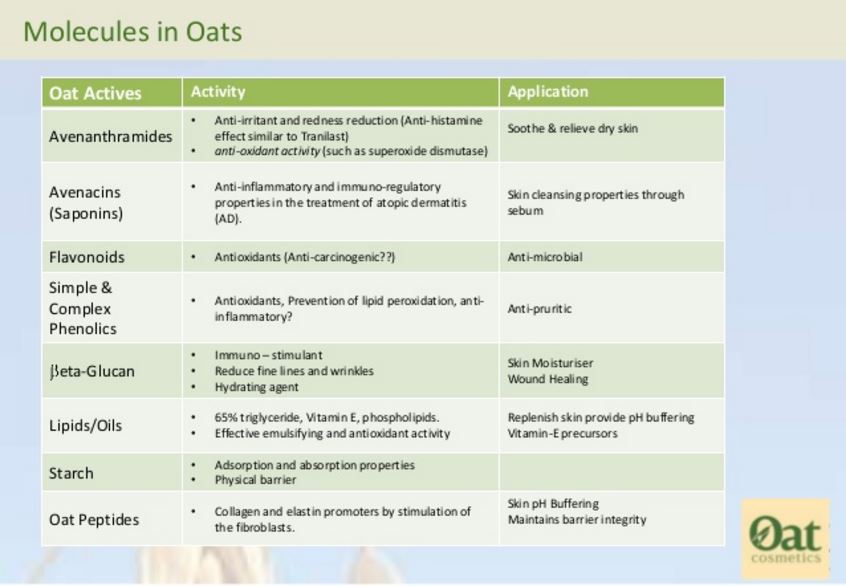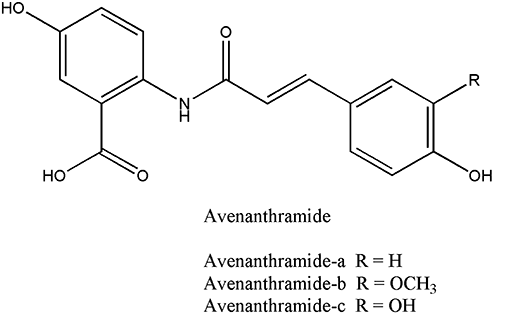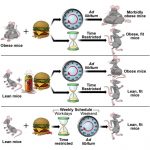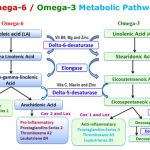Oat Avenanthramides
Oat Avenanthramides
Oats are one of the quintessential foods of the traditional Scottish diet. In terms of health benefits they are best known for their fibre content, particularly their beta-glucan content. Less well known is that this humble grain contains a unique class of more than twenty polyphenols known as avenanthramides, not found in any other foods. In recent years evidence has been emerging that these avenanthramides potentially have a wide range of beneficial effects on our health.
Structure of avenanthramides
As well as being a staple food in Scotland and other regions of northern Europe, oats also have a long history in medicine. They have been used to treat various conditions such insomnia, anxiety, and skin conditions, including eczema, and burns in various forms such as food, tea, or in baths. The use of wild oats (Avena sativa) has apparently been recorded for use in skin care as far back as 2000 BCE in Egypt and the Arabian peninsula and various skin conditions were often treated with oatmeal baths in the 19th and early 20th centuries. In 1989 the FDA recognised colloidal oatmeal as a safe and effective over the counter skin protectant drug and later in 2003 it was approved as an ingredient to be used as a skin protectant, one of the few botanical ingredients considered an effective skin protectant (Kurtz and Wallo 2007).
Until comparatively recently little thought had been given to the compounds in oats responsible for these anti-inflammatory activities of oats until the discoverly of avenanthramides in the late 1980’s (Collins 1989). These avenanthramides are a unique, group of soluble phenolic compounds which are not present in other cereal grains. These compounds are antipathogens (phytoalexins), meaning they are produced by the plant in to defend against plant pathogens such as fungi. While more than 20 different forms of avenanthramides are present in oats, three of these known as A, B, and C, make up the majority (Meydani 2009). These avenanthramides are now considered to form the active ingredients in oats responsible for their beneficial effects when applied to the skin.
Beyond the skin evidence is also emerging that these avenanthramides can have a range of beneficial effects within the body (Meydani 2009) . They have potent antioxidant properties potentially preventing the oxidation of cholesterol transporting low-density lipoproteins, at least in the lab (Chen 2004). Their anti-inflammatory effects may be able to help reduce inflammation in the cells lining our arteries (Liu 2004). Another interesting biological effect of avenanthramides is on nitric oxide (NO)-dependent vasodilation, a process that relaxes blood vessels leading to better circulation and reduced blood pressure (Nie 2006). Avenanthramides in very low concentrations have been shown to reduce inflammatory responses in skin cells and so mediate the anti-itch properties of oats when used on the skin, indicating that very little avenanthramides may be required to produce an effect (Sur 2008). Avenanthramides have been shown to be bioavailable in humans, being absorbed into the circulation, and to increase the antioxidant capacity of the blood in healthy older adults when fed enriched enriched oat products (Chen 2007). Even avenanthramides that are not absorbed could have an beneficial effects in our gut, given their anti-inflammatory effects when applied to the skin, this is speculative though.
Little information is currently available on the concentration of these avenanthramides present the oats used for our food, or the various oat products produced from them. One study that investigated the effects of processing on oats found that the avenanthramides content was much reduced in rolled oats, due to the effects of drum drying (2002). Rolled oats are steamed before being rolled flat, and require drying afterwards to remove the moisture added during the steaming process. The same study found that similar treatments to oatmeal, oats that had been heated and then then ground, had little on the avenanthramide content (2002). An earlier study found that the avenanthramides in products with added oatmeal such as bread, fresh pasta, muffins, and macaroni, survived well into the final products and end had an increase in free avenanthramides (Dimberg 2001). The amounts of avenanthramides can vary between different varieties of oats and survive storage and heating quite well (Dimberg 1996). A new method has even been proposed, using a process of “false malting” wherein selected or pre-treated grain is conventionally malted but does not germinate, that can dramatically increase the avenanthramide content of oats (Collins 2010). This suggests that the avenanthramides in the oats do survive into the food we eat, although there are still many unknowns about all the effects of oat varieties and processing techniques.
While little research has been carried out on the influence of avenanthramides in the amounts found in the oats we eat, they are an interesting group of compounds that potentially provide some extra benefits to eating oats and contribute to the healthfulness of oats as a part of the diet.
References:
. (2002) Effects of commercial processing on levels of antioxidants in oats (Avena sativa L.). Journal of Agricultural and Food Chemistry. 50:1890–1896.
“The effects of various commercial hydrothermal processes (steaming, autoclaving, and drum drying) on levels of selected oat antioxidants were investigated. Steaming and flaking of dehulled oat groats resulted in moderate losses of tocotrienols, caffeic acid, and the avenanthramide Bp (N-(4′-hydroxy)-(E)-cinnamoyl-5-hydroxy-anthranilic acid), while ferulic acid and vanillin increased. The tocopherols and the avenanthramides Bc (N-(3′,4′-dihydroxy-(E)-cinnamoyl-5-hydroxy-anthranilic acid) and Bf (N-(4′-hydroxy-3′-methoxy)-(E)-cinnamoyl-5-hydroxy-anthranilic acid) were not affected by steaming. Autoclaving of grains (including the hulls) caused increased levels of all tocopherols and tocotrienols analyzed except beta-tocotrienol, which was not affected. Vanillin and ferulic and p-coumaric acids also increased, whereas the avenanthramides decreased, and caffeic acid was almost completely eliminated. Drum drying of steamed rolled oats resulted in an almost complete loss of tocopherols and tocotrienols, as well as a large decrease in total cinnamic acids and avenanthramides. The same process applied to wholemeal made from groats from autoclaved grains resulted in less pronounced losses, especially for the avenanthramides which were not significantly affected.“
Chen, CY. et al. (2004) Avenanthramides and phenolic acids from oats are bioavailable and act synergistically with vitamin C to enhance hamster and human LDL resistance to oxidation. Journal of Nutrition. 134(6):1459-66
“The intake of phenolic acids and related polyphenolic compounds has been inversely associated with the risk of heart disease, but limited information is available about their bioavailability or mechanisms of action. Polyphenolics, principally avenanthramides, and simple phenolic acids in oat bran phenol-rich powder were dissolved in HCl:H(2)O:methanol (1:19:80) and characterized by HPLC with electrochemical detection. The bioavailability of these oat phenolics was examined in BioF1B hamsters. Hamsters were gavaged with saline containing 0.25 g oat bran phenol-rich powder (40 micromol phenolics), and blood was collected between 20 and 120 min. Peak plasma concentrations of avenanthramides A and B, p-coumaric, p-hydroxybenzoic, vanillic, ferulic, sinapic, and syringic acids appeared at 40 min. Although absorbed oat phenolics did not enhance ex vivo resistance of LDL to Cu(2+)-induced oxidation, in vitro addition of ascorbic acid synergistically extended the lag time of the 60-min sample from 137 to 216 min (P < or = 0.05), unmasking the bioactivity of the oat phenolics from the oral dose. The antioxidant capability of oat phenolics to protect human LDL against oxidation induced by 10 micromol/L Cu(2+) was also determined in vitro. Oat phenolics from 0.52 to 1.95 micromol/L increased the lag time to LDL oxidation in a dose-dependent manner (P < or = 0.0001). Combining the oat phenolics with 5 micromol/L ascorbic acid extended the lag time in a synergistic fashion (P < or = 0.005). Thus, oat phenolics, including avenanthramides, are bioavailable in hamsters and interact synergistically with vitamin C to protect LDL during oxidation.“
Chen, CY. et al. (2007) Avenanthramides Are Bioavailable and Have Antioxidant Activity in Humans after Acute Consumption of an Enriched Mixture from Oats . The Journal of Nutrition. 137(6): 1375-1382
“The consumption of polyphenols is associated with a decreased risk of cardiovascular disease. Avenanthramides (AV), alkaloids occurring only in oats, may have anti-atherosclerotic activity, but there is no information concerning their bioavailability and bioactivity in humans. We characterized the pharmacokinetics and antioxidant action of avenanthramide A, B, and C in healthy older adults in a randomized, placebo-controlled, 3-way crossover trial with 1-wk washout periods. Six free-living subjects (3 mol/L, 3 F; 60.8 ± 3.6 y) consumed 360 mL skim milk alone (placebo) or containing 0.5 or 1 g avenanthramide-enriched mixture (AEM) extracted from oats. Plasma samples were collected over a 10-h period. Concentrations of AV-A, AV-B, and AV-C in the AEM were 154, 109, and 111 μmol/g, respectively. Maximum plasma concentrations of AV (free + conjugated) after consumption of 0.5 and 1 g AEM were 112.9 and 374.6 nmol/L for AV-A, 13.2 and 96.0 nmol/L for AV-B, and 41.4 and 89.0 nmol/L for AV-C, respectively. Times to reach the Cmax for both doses were 2.30, 1.75, and 2.15 h for AV-A, AV-B, and AV-C and half times for elimination were 1.75, 3.75, and 3.00 h, respectively. The elimination kinetics of plasma AV appeared to follow first-order kinetics. The bioavailability of AV-A was 4-fold larger than that of AV-B at the 0.5 g AEM dose. After consumption of 1 g AEM, plasma reduced glutathione was elevated by 21% at 15 min (P ≤ 0.005) and by 14% at 10 h (P ≤ 0.05). Thus, oat AV are bioavailable and increase antioxidant capacity in healthy older adults.”
Collins F. (1989) Oat phenolics: avenanthramides, novel substituted N-cinnamoylanthranilate alkaloids from oat groats and hulls. Journal of Agriculture and Food Chemistry. 37(1),:60–66
“Fractionation of methanolic extracts of oat groats and hulls by anion-exchange chromatography revealed the presence of a series of anionic, substituted cinnamic acid conjugates, trivially named avenanthramides. Two-dimensional thin-layer chromatography (TLC) showed groat extracts contain more than 25 distinct avenanthramides, while hull extracts contained about 20. Some 15 were common to both groat and hull preparations. The substances were purified by repeated column chromatography on Sephadex LH-20, using TLC to monitor purity, and crystallized from aqueous acetone. The complete structures of 10 avenanthramides have been elucidated using ‘H and 13C nuclear magnetic resonance (NMR), mass spectroscopy (MS), ultraviolet absorption spectroscopy (UV), and hydrolytic techniques and confirmed by total synthesis. The physicochemical properties, potential biological activity, and distribution within the oat grain are discussed.”
Collins, FW. (2010) Avenanthramides in oats: A new method of producing whole oats and oat ingredients with greatly elevated avenanthramide levels. Online. AACC International Cereal Science Knowledge Database.
“Avenanthramides, of which over 35 distinct components have been found to date, represent the major readily-bioavailable, soluble phenolics present in the oat kernel These hydroxycinnamoyl alkaloids are found only in oats and have been shown to not only act as antioxidants but also to inhibit the pro-inflammatory processes associated with atherosclerotic disease progression. Based on recent in vivo pharmacokinetic results in humans and in vitro human vascular cell culture models, effective concentrations of avenanthramides required to influence vascular antioxidant status and the inflammatory response can be provisionally projected. Threshold response levels (approximately 30 to 60 mg from a dietary source delivery system such as a 50 g serving of oat bran) would require an oat product with at least 600 to 1,200 ppm total avenanthramides. This is a significantly higher concentration range than those currently recorded for existing oat varieties or existing whole grain oat products. Recently a process has been found that significantly increases the levels of avenanthramides in native oat kernels. Levels ranging from about 900 to 2,000 ppm in the whole groat, representing an enrichment factor of about 25- to 40-fold have been achieved by this process, without significantly altering the milling quality of the product. The process involves the concept of “false malting” wherein selected or pre-treated grain is conventionally malted but does not germinate. The selected oats refer to “dormant oat” varieties, i.e. varieties exhibiting secondary dormancy and preferably hulless, while non-dormant varieties can be made dormant using a simple dry heat process. In-depth HPLC analyses of avenanthramides from oats treated by this patent-pending process show little if any qualitative differences relative to untreated oats. Abrasion bran fractions show levels as high as 3,500 ppm total avenanthramides.”
Dimberg, LH. et al. (1996) Variation in Oat Groats Due to Variety, Storage and Heat Treatment. I: Phenolic Compounds. Journal of Cereal Science. 24(3):263–272.
Stability of Oat Avenanthramides. Cereal Chemistry. 78(3): 278-281
“The three main oat avenanthramides, N-(4′-hydroxy)-(E)-cinnamoyl-5-hydroxyanthranilic acid (Bp), N-(4′-hydroxy-3′-methoxy)-(E)-cinnamoyl-5-hydroxyanthranilic acid (Bf), and N-(3′,4′-dihydroxy)-(E)-cinnamoyl-5-hydroxyanthranilic acid (Bc), and their corresponding cinnamic acids, p-coumaric (P), ferulic (F), and caffeic (C), were investigated for stability to pH, temperature, and UV-light treatment. The retention of the avenanthramides after processing of oat-based food products was also analyzed. The avenanthramide Bc and the cinnamic acid Cwere sensitive to alkali and neutral conditions, especially in combination with heat treatment, whereas the other compounds studied were more stable. The cinnamic acids but not the avenanthramides were isomerized when irradiated with UV-light. The avenanthramides were restored after processing of oat-based products.”
Kurtz ES and Wallo W. (2007) Colloidal oatmeal: history, chemistry and clinical properties.Journal of Durgs in Dermatology. 6(2):167-70.
“Oatmeal has been used for centuries as a soothing agent to relieve itch and irritation associated with various xerotic dermatoses. In 1945, a ready to use colloidal oatmeal, produced by finely grinding the oat and boiling it to extract the colloidal material, became available. Today, colloidal oatmeal is available in various dosage forms from powders for the bath to shampoos, shaving gels, and moisturizing creams. Currently, the use of colloidal oatmeal as a skin protectant is regulated by the U.S. Food and Drug Administration (FDA) according to the Over-The-Counter Final Monograph for Skin Protectant Drug Products issued in June 2003. Its preparation is also standardized by the United States Pharmacopeia. The many clinical properties of colloidal oatmeal derive from its chemical polymorphism. The high concentration in starches and beta-glucan is responsible for the protective and water-holding functions of oat. The presence of different types of phenols confers antioxidant and anti-inflammatory activity. Some of the oat phenols are also strong ultraviolet absorbers. The cleansing activity of oat is mostly due to saponins. Its many functional properties make colloidal oatmeal a cleanser, moisturizer, buffer, as well as a soothing and protective anti-inflammatory agent.”
Meydani M. (2009) Potential health benefits of avenanthramides of oats. Nutrition Reviews. 67(12):731-5
“Oats are known to be a healthy food for the heart due mainly to their high β-glucan content. In addition, they contain more than 20 unique polyphenols, avenanthramides, which have shown strong antioxidant activity in vitro and in vivo. The polyphenols of oats have also recently been shown to exhibit anti-inflammatory, antiproliferative, and anti-itching activity, which may provide additional protection against coronary heart disease, colon cancer, and skin irritation.“
Avenanthramide, a polyphenol from oats, inhibits vascular smooth muscle cell proliferation and enhances nitric oxide production. Atherosclerosis. 186:260–266.
“The proliferation of vascular smooth muscle cells (SMC) and impaired nitric oxide (NO) production are both crucial pathophysiological processes in the initiation and development of atherosclerosis. Epidemiological data have indicated that diets rich in whole grain foods are associated with a reduced risk of developing atherosclerosis. Avenanthramides are polyphenols found exclusively in oats (Avena sativa L.). The present study was conducted to examine the effect of synthetically prepared avenanthramide-2c on the proliferation of SMC and NO production by SMC and human aortic endothelial cells (HAEC). Avenanthramide-2csignificantly inhibited serum-induced SMC proliferation. At a concentration of 120 microM,avenanthramide-2c inhibited more than 50% of SMC proliferation, as measured by [3H] thymidine incorporation, and increased the doubling time of rat SMC line (A10) from 28 to 48 h. Treatment of human SMC with 40, 80, and 120 microM avenanthramide-2cinhibited cell number increase by 41, 62, and 73%, respectively. In addition, avenanthramide-2c treatment significantly and dose-dependently increased NO production in both SMC and HAEC. At a concentration of 120 microM, avenanthramide-2c increased NO production by three-fold in SMC, and by nine-fold in HAEC. These increases were in parallel with the up-regulation of mRNA expression for endothelial NO synthase (eNOS) in both vascular SMC and HAEC. These results suggest that the avenanthramides of oats may contribute to the prevention of atherosclerosis through inhibition of SMC proliferation and increasing NO production.“
et al. (2008) Avenanthramides, polyphenols from oats, exhibit anti-inflammatory and anti-itch activity. Archives of Dermatological Research. 300:569–574
“Oatmeal has been used for centuries as a soothing agent to relieve itch and irritation associated with various xerotic dermatoses; however few studies have sought to identify the active phytochemical(s) in oat that mediate this anti-inflammatory activity. Avenanthramides are phenolic compounds present in oats at approximately 300 parts per million (ppm) and have been reported to exhibit anti-oxidant activity in various cell-types. In the current study we investigated whether these compounds exert anti-inflammatory activity in the skin. We found that avenanthramides at concentrations as low as 1 parts per billion inhibited the degradation of inhibitor of nuclear factor kappa B-alpha (IkappaB-alpha) in keratinocytes which correlated with decreased phosphorylation of p65 subunit of nuclear factor kappa B (NF-kappaB). Furthermore, cells treated with avenanthramides showed a significant inhibition of tumor necrosis factor-alpha (TNF-alpha) induced NF-kappaB luciferase activity and subsequent reduction of interleukin-8 (IL-8) release. Additionally, topical application of 1-3 ppm avenanthramides mitigated inflammation in murine models of contact hypersensitivity and neurogenic inflammation and reduced pruritogen-induced scratching in a murine itch model. Taken together these results demonstrate that avenanthramides are potent anti-inflammatory agents that appear to mediate the anti-irritant effects of oats.“
Liu L. et al. (2004) The antiatherogenic potential of oat phenolic compounds. Atherosclerosis. 175(1):39-49
“Avenanthramides are phenolic antioxidants, which are present in oats. Avenanthramides A, B, and C are the major constituents of the total soluble antioxidant phenolic compounds in oats. We tested the potential antiatherogenic activity of partially purified avenanthramides from oats by examining their effects on adhesion of monocytes to human aortic endothelial cell (HAEC) monolayers, expression of adhesion molecules, and production of proinflammatory cytokines and chemokines by HAEC. The oat avenanthramides mixture was prepared and partially purified by column chromatography. Thisavenanthramide-enriched mixture (AEM) had no toxicity to HAEC as tested up to 40 ng/ml. The pre-incubation of HAEC with 4, 20, and 40ng/ml AEM for 24h significantly decreased adhesion of U937 monocytic cells to interleukin (IL)-1beta-stimulated HAEC in a concentration-dependent manner. Pre-incubation of HAEC with AEM at 20 and 40 microg/ml, but not at 4 microg/ml, for 24h significantly suppressed IL-1beta-stimulated expressions of intracellular adhesion molecule-1 (ICAM-1), vascular cell adhesion molecule-1 (VCAM-1), and E-selectin and the secretion of proinflammatory cytokines IL-6, chemokines IL-8 and monocyte chemoattractant protein (MCP)-1. These data provide evidence for the potential anti-inflammatory and antiatherogenic effects of antioxidant avenanthramides present in oats.“







